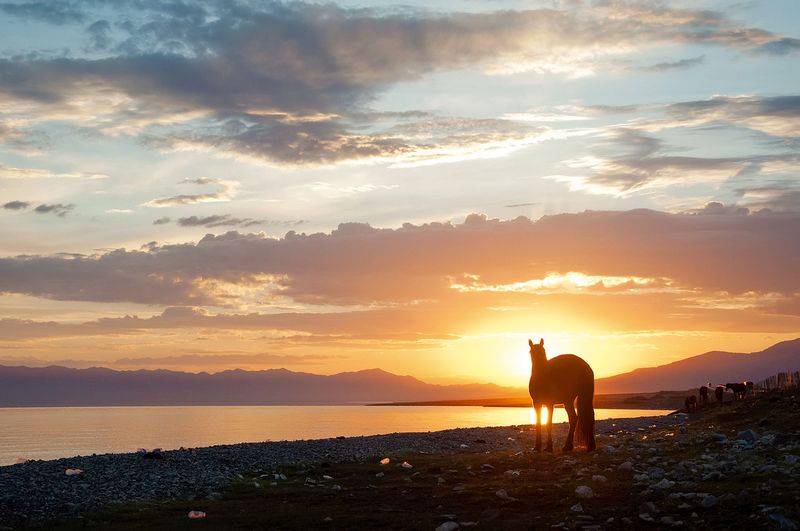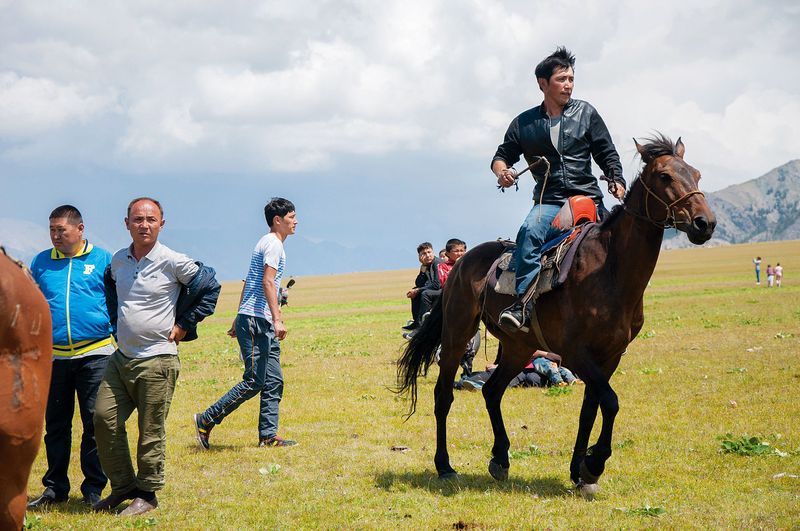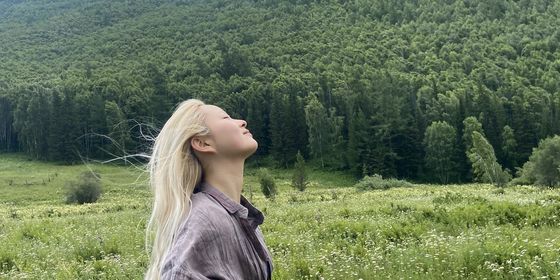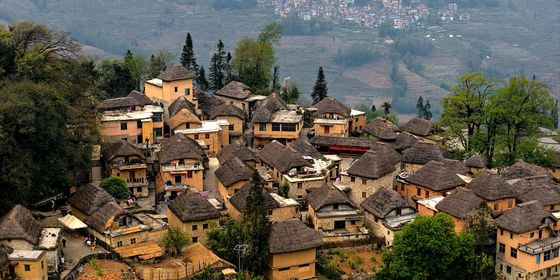A two-day Kazakh-Han wedding transforms pastures of western Xinjiang, as change comes to local herders’ lives
Kazakh herders have a legend that Sayram (Sailimu) Lake was formed by the tragic tears of two separated lovers. On this special day, though, the azure pool reflects only the joyous tears of two distant lovers united on its shores. The slope around the lake is dotted by the white wedding yurts of Li Yunping and Shalkar (Xialiha), who met two years ago on a midsummer’s day just like this.
Li, a white-collar worker from Taipei, arrived at Sayram Lake as a backpacker in the summer of 2011. Here, she met Shalkar, a young Kazakh man from a local herding family. While the circumstances of their lives seem different, Li believes that the two of them are soulmates—“Shalkar is an honest and pure person from the bottom of his heart,” she tells the reporters, who are flocking to the lake to cover the inter-ethnic celebration. “We are the same at our core.”
Both the bride’s and the groom’s families opposed the relationship at first due to differences in their lifestyle. Now, however, Li’s mother is telling the journalists, “My daughter always tells me that the life of the spirit is more important than the life of material things. And in the end we respect that, and wish her well.”
Like the bride, I too never imagined I would end up at the shores of Sayram Lake, swept here by the wayward winds of serendipity. One day ago, in the check-in line at an Urumqi hostel, a fellow backpacker from Sichuan province struck up a conversation with me. She told me that she had just returned from the city of Ili (Yining) in northwest Xinjiang, less than 100 kilometers from the Kazakhstan border. The owner of a youth hostel there, a good friend of the bride, was taking all his lodgers to a Kazakh-style wedding the next day.
I looked up the hostel on Baidu and called. To my disbelief, the owner answered and asked whether I could arrive by 8 the next morning, which was when the bus would depart for Sayram Lake; I took it as a divine invitation. After spending nine hours cramped on the floor of an overnight, standing-room-only train, I arrive at the gates of Doppa Hostel with just 20 minutes to spare. The wedding delegation turned out to be an eclectic and jolly bunch of young Han travelers clad in brightly colored waterproof jackets.

The shores of Sayram Lake are dotted with the tents of local herding families
Most travelers divulge few details about the lives they left behind, but a young man from Yunnan province quietly tells me that he quit his job in Guangzhou. His WeChat nickname is Samsara, Sanskrit for “passing through” in the world of flesh. Some have been on the road for months, camping on mountains and living on a few RMB a day. A few travelers drop hints that their families and friends think them foolish for coming to Xinjiang, a region of which most Chinese understand little beyond the tales of ethnic unrest and public riots.
But there is something about these landscapes, unfurling magnanimously toward all horizons, that shakes many of us deeply. Toward the end of our two-hour bus ride, I wonder whether my own grandmother, who was displeased to hear about my trip, could imagine a scene as serene as this. Yellow canola flowers carpet these hills for a few brief but breathtaking weeks each summer—eruptions of color before the winter again veils the lake in mist and ice. White yurts billow in the distance, like little clouds on a brilliant sea of green and yellow.
The bus drops us off close to the wedding grounds. As guests, our first order of business is to obtain a gift for the couple. Calculating that, by contributing 100 RMB each, we can purchase a goat, we flag down a nearby herd. After a few minutes of chasing and scuffling, the herder manages to secure a rope around the neck of one of his goats, and in an impressive maneuver, grabs its feet and swings it onto the back of a motorcycle. “These bikes are our horses now,” he jokes. Many necessities are transported in on the back of these motorcycles—including drinking water.
Upon arriving, a burst of sudden rain sends guests scurrying into the tents. I find myself in the kitchen tent, where I help the women wash dishes and watch them prepare lamb-and-carrot shouzhuafan (Xinjiang-style pilaf) in a kazan, a large metal stove large enough to feed more than 50. The meal is later doled out on plates that we eat together on the grass. A cup of mare’s milk is passed around; the faces of many, including mine, pucker at the sourness. We opt for salty milk tea.
Within a few hours, somehow the sky is blue again. Like the sun emerging from a cloud, the bride emerges for the first time from her yurt shrouded in golden-rimmed white cloth, veiled to the waist from the tip of her saukele, a tall conical headdress swathed with colorful patterned fabrics. A tuft of owl feathers adorn the cloth, symbolizing good luck. The saukele is typically the most expensive part of a bride’s costume; it’s said to cost as much as a herd of horses in the past.

The bride emerges in traditional Kazakh dress, with owl feathers clipped to the headdress for good luck
The guests cheer as Li’s veil is lifted over her saukele, revealing eyes rimmed with indigo and a half-grinning face. Li struggles to remain solemn, as this was traditionally the day a bride would leave her birth family, not to return for a year. Li’s new mother-in-law welcomes her into her family with a customary kiss on the cheek.
The wedding procession begins, led by two dombra players. Strumming on these two-stringed lutes, the musicians sing folk songs with galloping rhythms. The slope forms a natural amphitheater for the young and elderly alike to lounge in the lush grass, sometimes leaning against each other with cheeks pressed together. The musicians take turns improvising lyrics, like a sort of Kazakh rap battle. The Kazakh uncles and aunties howl with laughter.
Many of the adult Kazakh men and women do not speak fluent Mandarin, but nearly all the children do, with no accent. A bashful 9-year-old boy introduces himself as Narbota, the name of a stream across the border in Kazakhstan. “But all of my friends at school call me Baozi [steamed bun].” Narbota tells me that children attend the school near Guozigou (“Fruit Valley”) Bridge, where the curriculum is taught in Mandarin.

Guozigou Valley lies within the Northern Tianshan Mountains, also known as the “Heavenly Mountains”
Herding is one of humankind’s oldest professions. Nevertheless, the last two decades have brought changes to the lives of herders in the region. For one, the massive, 360-meter Guozigou Bridge on the southern banks of Sayram Lake was completed in 2011, stretching on stilts 180 meters above a formidable valley. The bridge was part of Beijing’s “Western Development” initiative that sought to spread development away from the coasts. A distance that would have once taken at least a day on horseback can now be driven across in minutes.
Sayram Lake also sits on a growing trade route between China and Kazakhstan. The Guozigou route connects Urumqi, 570 kilometers to the east, with the Khorgos Land Port, a free-trade zone between China and Kazakhstan just 80 kilometers to the west. According to Kazakhstan’s foreign ministry, bilateral trade increased 100-fold in the five years after the bridge’s completion.
With their pastures bisected by a trade route vital to their government’s geopolitical and economic interests, the lives of these Kazakh herders have changed indelibly. Narbota now learns Mandarin at school, new roads are built across valleys, and more and more tourists begin to arrive at their pristine lake. However, many hold onto their herding lifestyles, even as they buy electric generators to charge the phones on which they connect with friends on WeChat.
Although motorcycles and cars are becoming ubiquitous, all local children, even 9-year-olds, feel at home on horseback. Narbota excuses himself to hop onto the back of a horse. “It’s my uncle’s horse,” he says excitedly, “I only sometimes get to ride it.” He stays on the chestnut mare all afternoon long, as the horse circles the pasture and buries its face in the grass, grazing idly.

Horses gather by the water’s edge for a drink as the sun rises over the lake
“I like your dress,” I say to a young girl with light brown hair and hazel eyes, “especially the color.” It is electric green, with swirling gold and black accents.
“I don’t like it. My mom made me wear it,” she puffs. “Here, you put on my hat!” she suggests, eyes glistening with mischief. I feel the tall plume wobbling as she presses it onto my head. She cackles and introduces herself as Nana, 11 years old. “I like to sing,” she says, “Do you sing?” Turns out she knows far more Chinese pop songs than I do; the only overlap in our knowledge is Qu Wanting’s “You Are in My Song.” We belt it toward the hills.
As night descends, a bonfire pierces the blue of dusk, blazing over five feet tall. The Kazakhs invite the Han guests to link hands and run in two concentric circles. The Kazakh girls are wearing bright dresses—red, pink, blue, with layers of ruffles and matching hats with feathered plumes. They take turns dancing, spinning until their dresses whirl into colorful discs. The rest of us try to follow along to the bouncing shoulders and syncopated steps, but most of us never get it quite right. We have a good time all the same. At the end of the night, the fire is extinguished and it is pitch black. With no electricity, we have no choice but to retire to our yurts to sleep.
The next morning, dozens of horsemen arrive on the grassland, the riders mostly men from neighboring communities. Their faces are severe, as if preparing for battle. “We are about to begin the horseback games,” a boy explains.

Five thousand years of history on the steppes have given rise to many horseback games still well-loved today
“Oh, can I play? I can ride a horse,” I offer. The day before, some Kazakh teenagers had let me take one of their horses up a mountain; I had managed to make it up and down without falling off.
“No,” the boy says, deadpan. “You might die.”
As one of the games begin, riders begin galloping and nearly collide several times, clearly vying for possession of a white object.
“What are they throwing around over there?” I ask.
“A headless lamb,” the boy replies.
I learn that the game is a favorite across Central Asia, known to Kazakhs as kokpar, Afghans as buzkashi, and Kyrgyz as kokboru. The goal is to seize the lamb’s corpse and carry across the goalposts. It is credited as being one of the forefathers of polo, but more dangerous (those lambs ain’t light).
A more lighthearted amusement is kyz kuumai. Somebody explains: Young men chase young women on horseback, each choosing one at whom to exclaim sweet words of endearment. When they cross a finish line, the roles switch—the women chase the men, horsewhips poised for revenge. The more you like him, the harder you’ll crack.
The day passes to the sound of shouts and galloping under another azure midsummer sky.
The groom’s uncle, who scurries about busily during the wedding, declares to the journalists, “This is a special wedding. They are right to walk their own path. Our family supports their marriage; no matter the ethnicity. I believe that from today onward, the couple will open a new field together.”
And then the games disband, the yurts are dismantled, and the mountainside is once more a pasture for wandering sheep. When it is all over, I wade into the cold, clear waters of Sayram Lake and wonder how I even got here. Perhaps like the lovers, I have chosen a path that opens new fields in the heart. I know there are yellow flowers blooming there.
I find out that Sayram means “blessing” in the Kazakh language. It feels apt.
Photography by Tina Xu
Serendipitous Sayram is a story from our issue, “The Noughty Nineties.” To read the entire issue, become a subscriber and receive the full magazine.












